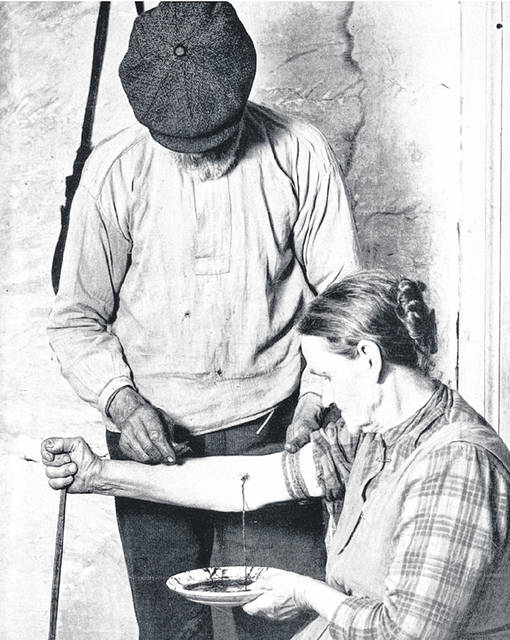
There have been some questionable medical practices in the history of the United States. One popular practice, though, involved the “letting” of blood to leave the body, through practices like using live leeches and piercing and draining blood.
Bloodletting was around long before Highland County physicians used it in their practices. Ancient Greek and Roman doctors used bloodletting as a preventative measure and a treatment for common illnesses such as pneumonia and smallpox, but it was also used in an attempt to decrease inflammation before surgeries and even treat cancer. When a patient showed symptoms of an illness, physicians might suggest that “excessive blood” be removed to balance the body. This didn’t do much and often even worsened the patient’s condition.
An interesting chapter of bloodletting includes the infamous parasitic water-dwellers — leeches. Leeches used in bloodletting were allowed to feed on the skin of the host because the bloodletting would be simpler and cleaner than puncturing the skin in traditional practices. Interestingly enough, leech therapy is actually used today and may help certain chronic conditions. Leeching was much more uncommon than regular bloodletting, but it still manages to pop up in period newspapers as a recommended treatment.
Ironically enough, Highland County papers criticized ancient doctors on their medical practices, stating, “We sorrow over the stupidity of the Dark Ages, when leeches and the barber were one,” according to an 1884 article titled “The Domestic Doctor.” In the past, barbers would both perform medical procedures and grooming services. The classic “barber’s pole” outside many shops today is said to represent the grisly history of barbers — the “cap” at the top represents where the leeches were held on the original pole, the basin at the bottom held collected blood, and the colors explained what services the barbers were prepared for that day.
Red stood for bloodletting and leeching; white was for setting bones, pulling teeth, or bandaging an injury; and blue indicated just a shave.
In Highland County, bloodletting was seen as a last resort in medical treatments toward the end of the 1800s and beginning of the 1900s. The News-Herald in Hillsboro recognized bloodletting in a 1909 article as a medical practice of the “ancient world” that was still in use at the time (and considered to be effective). There were many side effects to bloodletting, such as the obvious nutrient deficiencies and possibility of infection from open sores, so it was seen as an option to be saved only if the medicine prescribed didn’t work.
Bloodletting is no longer practiced for good reason. Advancements in science and technology reduce the need for drastic procedures to treat common ailments, and we can look back at this pseudoscience and appreciate advances in modern medicine.
Isabella Warner is a stringer for The Times-Gazette.
Information for this story came from: https://www.researchgate.net/figure/Bloodletting-in-Vaermland-Sweden-1918-Bloodletting-was-used-as-a-cure-for-epilepsy_fig2_269337092; https://www.history.com/news/a-brief-history-of-bloodletting; and https://www.history.com/news/why-are-barber-poles-red-white-and-blue.


